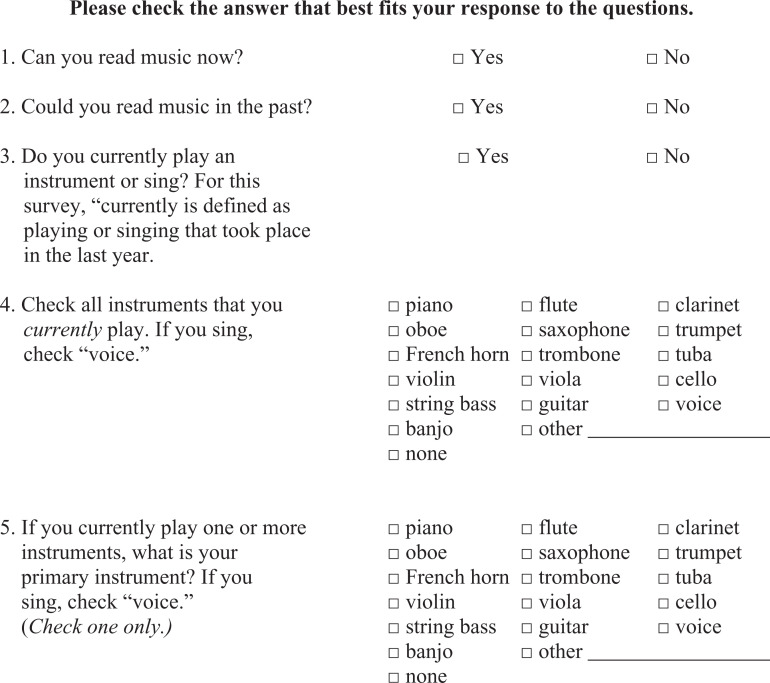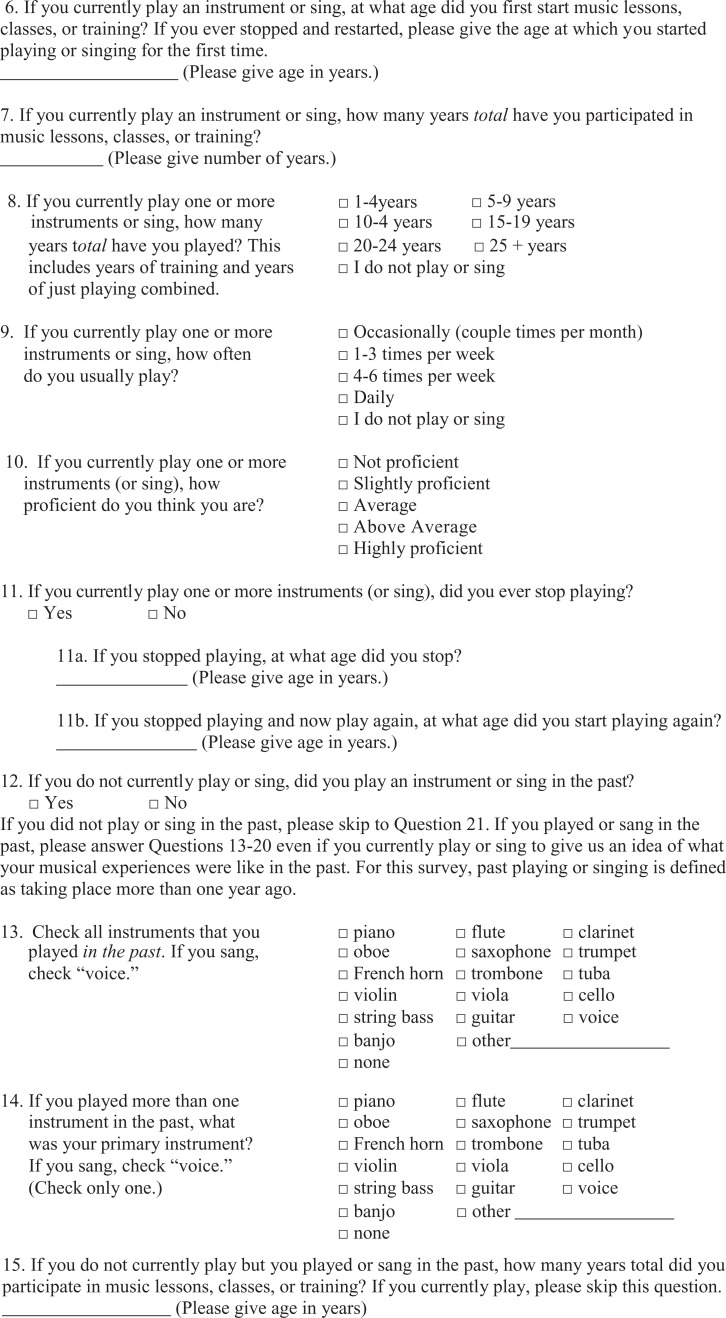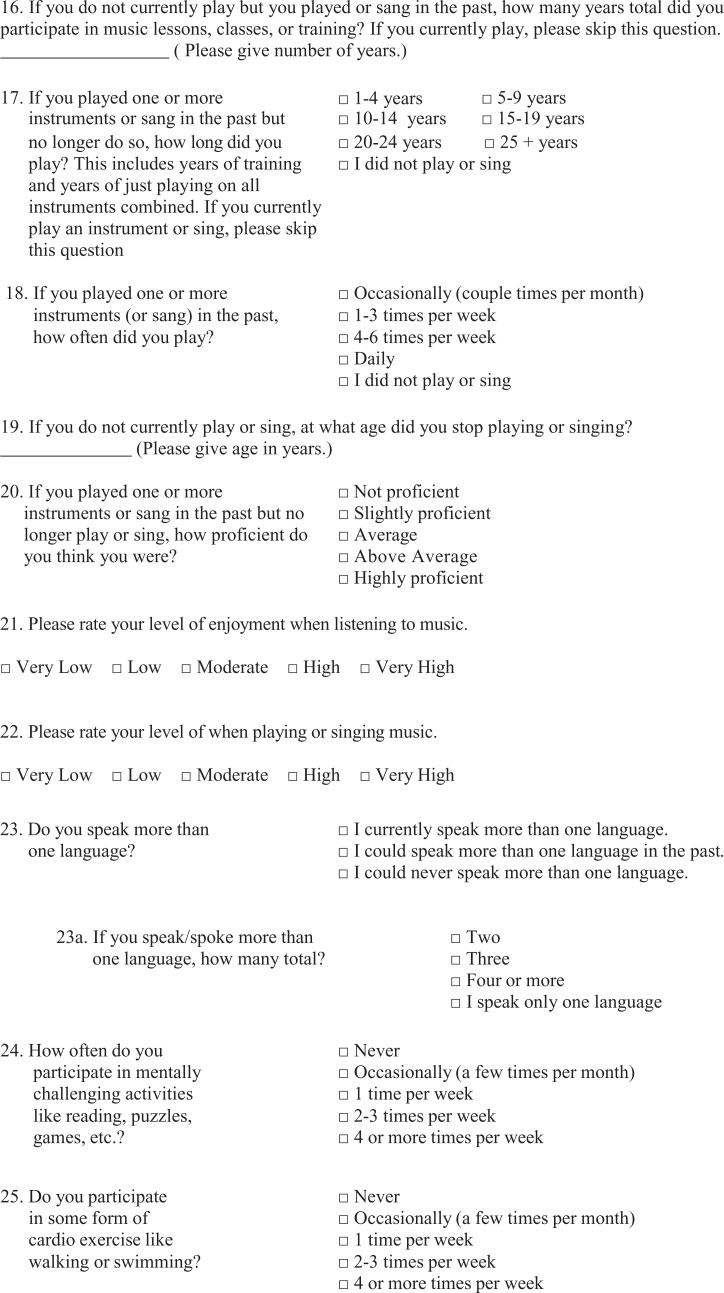Abstract
This study investigated the effects of early- to midlife musical training on cognition in older adults. A musical training survey examined self-reported musical experience and objective knowledge in 237 cognitively intact participants. Responses were classified into low-, medium-, and high-knowledge groups. Linear mixed models compared the groups’ longitudinal performance on the Animal Naming Test (ANT; semantic verbal fluency) and Logical Memory Story A Immediate Recall (LMI; episodic memory) controlling for baseline age, time since baseline, education, sex, and full-scale IQ. Results indicate that high-knowledge participants had significantly higher LMI scores at baseline and over time compared to low-knowledge participants. The ANT scores did not differ among the groups. Ability to read music was associated with higher mean scores for both ANT and LMI over time. Early- to midlife musical training may be associated with improved late-life episodic and semantic memory as well as a useful marker of cognitive reserve.
Keywords: musical training, memory, cognitive reserve, aging
Introduction
Age-related cognitive deficits are often associated with a number of impairments in executive functioning, visuospatial skills, motor speed, and processing speed. Researchers are increasingly looking for strategies that integrate multiple neural networks to mitigate or even prevent age-related cognitive decline. 1 Music making, which is multisensory and involves motor planning, preparation, and execution, is increasingly recognized for its potential to facilitate brain plasticity. 2
According to Bugos and colleagues, 1 active music making promotes skill development that directly influences memory formation and retrieval, and making music involves a wide array of skills that place unique demands on the nervous system. 3 Training on a musical instrument encompasses motor and auditory tasks, reading of musical notation, multimodal sensory integration, intensive deliberate and repetitive practice, and perhaps most importantly, is intrinsically motivating. 1,2 It has been suggested that music education contains all of the necessary components to “engage and preserve attention and memory systems throughout the lifespan.”1(p465)
Engaging individuals across the life span is especially important given the growing body of evidence that lifestyle factors, including stimulating cognitive activities, may positively impact cognitive reserve and even postpone the onset of Alzheimer’s Disease (AD) or other dementias. 1,4,5 Because it is now understood that plasticity occurs across the life span 2 and that plasticity may be recruited in late life to compensate for age-related cognitive decline, 6 music making has the potential to be an effective intervention for neurological and developmental disorders as well as age-related cognitive decline. 1,2
There is growing evidence that music making actually impacts brain structure and function in both adulthood and older adulthood. Lappe and colleagues 7 studied adult nonmusicians who learned to play a musical sequence on the piano during a 2-week period and found that those who played the piano demonstrated significantly different cortical responses after training. Likewise increased responses in the hippocampus following 2 semesters of intensive aural training were observed in music academy students using functional magnetic resonance imaging studies. 8 Additional studies on musical and nonmusical brains provide limited support for music as a protective factor against cognitive decline. Baird and Samson 9 concluded that explicit musical memory is typically impaired in AD but implicit (ie, procedural musical memory or the ability to play a musical instrument) can be preserved in musicians. The authors suggest that this is related to brain regions affected by AD pathology, with those regions involved with procedural memory not typically impacted. Another study found normal to partial retention of musical abilities in 75% of adults with AD. 10 Researchers have even hypothesized that dementia may be less prevalent among orchestral musicians and that this could be due to a lifetime engaged in a cognitively stimulating endeavor. 11
The frequency of participation in cognitive activities by older adults has also been associated with lower risk of cognitive decline, and results from several musical training studies with older adults are consistent with this premise. 2 Sluming and colleagues 12 reported that practicing musicians have greater gray matter volume in the left inferior frontal gyrus as compared to nonmusicians, and that musicians appear to be less susceptible to age-related brain degenerations. Verghese et al 5 followed individuals aged 75 years and older for a 5-year time period. Individuals who frequently played a musical instrument were less likely to develop dementia, and music as a cognitively stimulating activity appeared to have stronger effects than reading, writing, or doing crossword puzzles. Finally, adults aged 60 to 85 years who participated in piano lessons scored significantly better on cognitive tests of attention and working memory than adults who did not participate. Interestingly, cognitive benefits were not sustained when regular practice and training were discontinued. 1
Perhaps the most promising data come from a recent Hanna-Pladdy and MacKay 6 study in which the authors investigated the relationship between instrumental musical activity and cognitive aging in healthy older adults. Results indicated that advanced musicians, that is, those with more training outperformed nonmusicians in cognitive domains susceptible to decline suggestive of AD, signifying possible advantages related to musical training that could contribute to cognitive reserve. Older adults themselves, when asked about participation in musical training, even appear to recognize the positive impact that musical participation has on their health. 13 Individuals involved in an older adult musical training program were surveyed, and of the individuals surveyed, almost 70% commented that musical training had affected their health, with 98% of those comments being positive. Of the positive comments, 21% were related to cognitive stimulation.
The above information, coupled with data that show early-life musical training enlarges several brain regions, improves plasticity in young adults, and increases interaction between semantic and episodic memory structures in young musicians, indicates promise for musical training as a cognitive reserve factor. 14 –17 However, more research is needed. The purpose of the current project was to evaluate the association between early- to midlife formal training in music on late-life semantic (verbal fluency) and episodic memory among cognitively normal older adults. Specifically we sought to test the hypothesis that higher levels of musical training would be associated with increased cognitive reserve as reflected in cognitive performance over time.
Methods
Participants
A convenience sample of individuals who had previously consented to serve as research participants with the Sanders-Brown Center on Aging, a National Institute on Aging-funded Alzheimer’s Disease Center (ADC) at the University of Kentucky, were approached to participate in this study during March to June 2012. The ADC cohort comprises a convenience sample of older adults (age ≥60 years) from central Kentucky. Participants are given annual cognitive and clinical assessments and donate their brains upon death. Cognitive assessments are administered by trained technicians blind to musical training status, which is not routinely collected. Exclusion criteria include prevalent neurological, psychiatric, and disabling medical disorders, as well as prevalent dementing illness (see Schmitt et al for a detailed listing and explanation of recruitment and procedures). 18 All research activities were approved by the University of Kentucky institutional review board. Each participant provided written informed consent. Patients included in the current analysis (N = 237) completed the musical training survey (MTS) and were cognitively intact (global Clinical Dementia Rating [CDR] = 0) 19 at their most recent ADC assessment.
Procedures
A MTS was created by research staff. This survey contained self-reported musical training information as well as an objective, 21-question test of musical knowledge. Objective musical questions were based on the National Standards for Arts Education 20 with specific objectives gathered from the K-12 Music Scope and Sequence from Wallingford Public Schools and the Perklomen Valley School District Course/Content Area Scope and Practice for High School Level Music Theory I and II (Grades 9-12). 21,22 After pilot testing, MTS were mailed to 385 ADC participants (with global CDR = 0 at the last ADC evaluation prior to the MTS mailing) in March 2012 along with a cover letter explaining the project. As stated previously, the surveys contained self-reported musical training information (instruments played, number of years of experience, etc) and objective musical questions. Objective questions were a series of multiple choice questions designed to assess music theory (ie, music reading) knowledge. These questions were divided into 3 levels of difficulty for scoring purposes: “easy,” “medium,” and “hard.” These levels were based on the suggested progression of musical skills development recommended by National Standards for Arts Education. 20 Easy questions consisted of fundamental skills taught first in the progression of core music standards. Medium questions focused on expanded fundamentals knowledge. Hard questions required the greatest knowledge of music content and incorporated concepts typically expected at the end of music standards development.
Statistical Analysis
An unadjusted latent class analysis (LCA) 23,24 was performed on the responses to the 21 objective knowledge questions. The number of correct responses was tracked and missing responses were imputed as incorrect. The PROC LCA 25 in PC-SAS 9.3 was used to carry out the analysis, which created 3 knowledge groups. Linear mixed models were used to compare the groups’ longitudinal annual performance on the Animal Naming Test (ANT; semantic memory or category verbal fluency) and the Wechsler Logical Memory Story A Immediate Recall (LMI; episodic memory, immediate recall) while controlling for age at ADC enrollment (baseline), time since baseline, years of education, and sex. 26 Additional analyses were performed to assess the effect of self-reported ability to read music, which implies formal musical training, rather than the LCA-derived knowledge groups, and whether observed differences based on musical training would be preserved given the inclusion of another marker of cognitive reserve, estimated full-scale IQ (derived from the National Adult Reading Test), 26 which was available on a subset of participants (n = 201).
Results
Completed surveys were obtained from 237 of 385 participants for a response rate of 61.6%. Nonrespondents were similar in age (P = .11) and sex distribution (P = .14) but were slightly less educated (mean difference = 1.12 ± 2.62 years; P < .0001) and comprised more minorities (17% vs 8%; P = .006). Respondents who completed the MTS were 77.4 ± 6.4 years old on average, had an average of 16.6 ± 2.6 years of education, were 67% female, and 8% minority (Table 1). Average length of follow-up since baseline study enrollment was 7.8 ± 5.6 years. Among those who reported ever playing an instrument or singing (n = 160), the average initiation age was 13.5 ± 17.3 years (median = 9 years), and the average length of training/study was 11.1 ± 10.7 years (median = 8 years).
Table 1.
Musical Training Survey Respondent Characteristics: Overall and by Knowledge Group.
| Characteristica | All Respondents (N = 237) | Low Knowledge (n = 77) | Medium Knowledge (n = 78) | High Knowledge (n = 82) |
|---|---|---|---|---|
| Age at UDS, years | 77.4 ± 6.4 | 78.5 ± 6.9 | 77.2 ± 6.6 | 76.6 ± 5.6 |
| Education, years | 16.6 ± 2.6 | 15.6 ± 2.8 | 16.6 ± 2.6 | 17.4 ± 2.3 |
| Sex, % F | 67.1 | 53.3 | 71.8 | 75.6 |
| Race, % minority | 7.6 | 10.4 | 6.4 | 6.1 |
| MTS objective items correct | ||||
| Total (21 possible) | 8.9 ± 7.4 | 0.4 ± 0.9 | 8.1 ± 3.0 | 17.5 ± 2.3 |
| Easy (7 possible) | 3.8 ± 2.7 | 0.3 ± 0.7 | 4.5 ± 1.2 | 6.4 ± 0.7 |
| Medium (7 possible) | 2.8 ± 2.6 | 0.08 ± 0.3 | 2.5 ± 1.6 | 5.7 ± 1.1 |
| Hard (7 possible) | 2.2 ± 2.6 | 0.04 ± 0.2 | 1.1 ± 1.2 | 5.4 ± 1.4 |
| Can read music, % | 65.0 | 14.3 | 80.8 | 97.6 |
| Currently play or sing, %b | 37.6 | 8.1 | 29.0 | 73.4 |
| Estimated full-scale IQ | 116.8 ± 7.0c | 114.1 ± 7.3d | 116.8 ± 7.1e | 119.1 ± 5.7f |
Abbreviations: F, female; MTS, Musical Training Survey; UDS, Uniform Data System.
a All results presented are mean ± SD unless otherwise noted.
b Currently denotes within the last year.
c n = 201.
d n = 62.
e n = 64.
f n = 75.
The LCA classified respondents into low- (n = 77), medium- (n = 78), and high-knowledge groups (n = 82; see Table 1). The high-knowledge group had more years of education (P = .04) and more women than the low-knowledge group (P = .006). High-knowledge respondents had higher unadjusted mean scores over time on LMI than the low-knowledge respondents (see Figure 1). For both ANT and LMI, unadjusted mean scores were significantly higher among high-knowledge participants at baseline, and this difference was preserved for at least 10 years.
Figure 1.
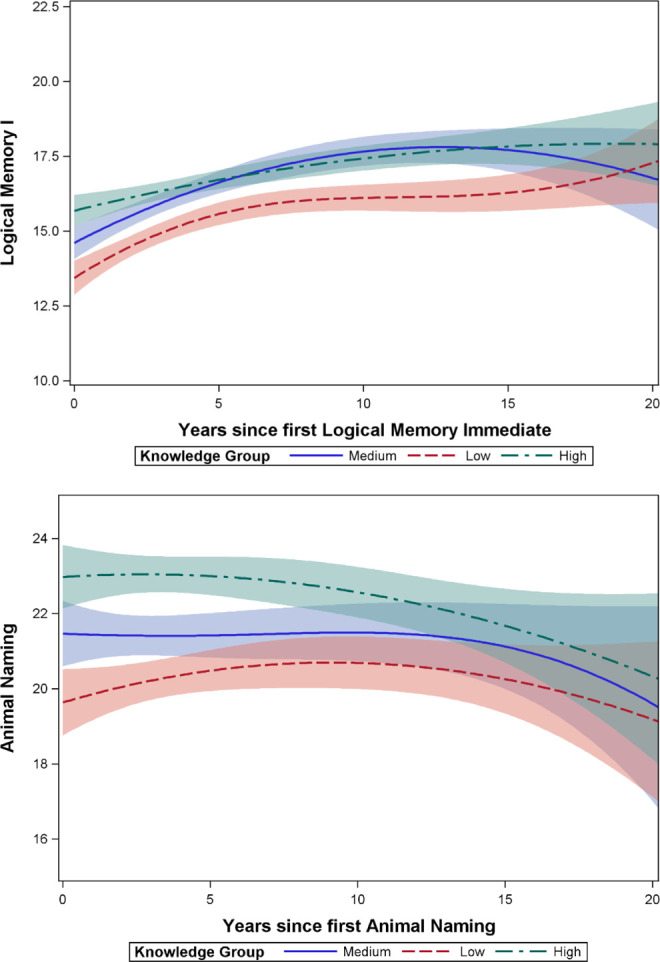
Penalized B-spline smooth of the unadjusted average profiles for each latent class derived-musical knowledge group. Cognitive tests were administered annually. Shaded bands are 95% confidence limits (N = 237).
Follow-up assessment data sparseness increases after 10 years, and the confidence bands in Figures 1 and 2 widen accordingly. Additionally, splines are known to become erratic near data boundaries, 27 and thus the figures should be interpreted cautiously for follow-up assessments more than 15 years after baseline.
Figure 2.
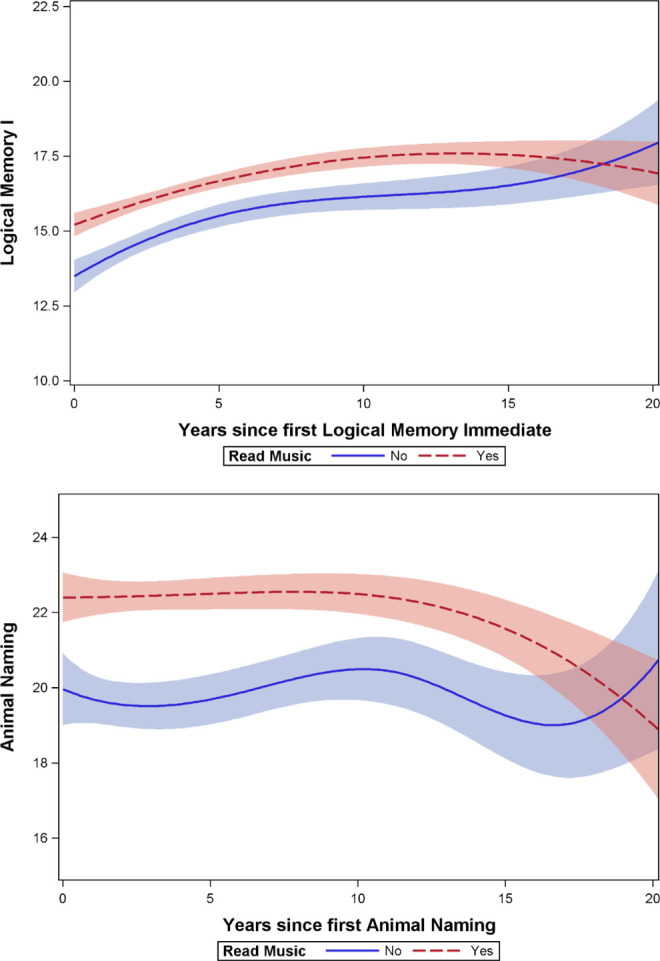
Penalized B-spline smooth of the unadjusted average profiles based on self-reported ability to read music. Cognitive tests were administered annually. Shaded bands are 95% confidence limits (N = 237).
Linear mixed model results showed that after controlling for demographic effects, high-knowledge respondents scored an average of 1.3 ± 0.5 points higher (P = .02) than the low-knowledge respondents. The ANT scores were also higher in high-knowledge than the low knowledge respondents (average 1.7 ± 0.7 points; P = .02). For both LMI and ANT, the medium-knowledge group was not different from either high or low group.
Self-reported ability to read music was correlated with scores on the objective knowledge scale because participants who could read music answered 12.7 ± 5.9 items correctly, while those who could not read music answered 1.7 ± 3.2 correctly (t 235 = 15.9; P < .0001). Ability to read music was associated with both higher unadjusted (Figure 2) and adjusted mean scores over time for both ANT (1.5 ± 0.6 points; P = .021) and LMI (1.3 ± 0.4 points; P = .0028).
Finally, while the inclusion of estimated full-scale IQ does mitigate the effect of the LCA-derived knowledge group on mean ANT scores (P = .16), high knowledge respondents maintain a 1.3 ± 0.5 point advantage on mean LMI scores over low-knowledge respondents (P = .02). Self-reported ability to read music provides an advantage in both mean ANT (1.5 ± 0.6; P = .02) and LMI (1.3 ± 0.5; P = .005) scores even when adjusted for estimated full-scale IQ.
Discussion
Results from this preliminary investigation provide support for the hypothesis that higher levels of musical training are associated with improved semantic and episodic memory among highly educated, cognitively normal older adults. In all analyses, respondents with high musical knowledge or who reported that they could read music had higher mean logical memory immediate recall scores compared to respondents with low musical knowledge or who reported they could not read music, respectively. There was also evidence that Animal Naming scores are improved in these same comparisons, although the difference was not preserved after the inclusion of estimated full-scale IQ. This suggests that formal musical training in early- to midlife, even when measured only by self-report, is associated with improved late-life episodic and semantic memory performance in this cohort and may be a useful marker of cognitive reserve.
Previous research 6 has shown differences in musicians and nonmusicians on measures of cognitive functioning, but this study highlights differences among individuals with varying levels of musical training (as defined by the ability to read musical notation). Results from the current study suggest that increased levels of training, as evidenced by higher scores on the MTS objective knowledge questions and the ability to read music, may provide increased benefit. If true, this would be consistent with the data that suggest individuals with more years of education (ie, increased exposure) have higher levels of cognitive functioning throughout adulthood. 28 Perhaps musical training increases protective factors much in the same way that general education does: the greater the training, the greater the protective factor.
A number of studies demonstrate short-term effects of musical training. For example, Hyde and colleagues 29 found that only 15 months of musical training in early childhood resulted in structural brain changes, and Schellenberg 30 found enhanced IQ after 36 weeks of musical training. Some studies have even found longer term benefits of musical training, finding a positive association with IQ in young adulthood and musical training in childhood. 31 Results from this exploratory investigation provide an argument for the sustained effects of musical training on cognitive functioning well into older adulthood.
It is important to note that high knowledge participants and participants who could read music in this study had higher mean years of education, and education has been positively associated with cognitive reserve. 32 While residual confounding due to adult lifestyle and socioeconomic factors associated with higher years of education cannot be ruled out, given that both years of education and estimated full-scale IQ were adjusted for in the current investigation, the results can still be viewed as promising. Additionally, future research should explore structural differences in older adults with musical training to determine whether the brain differences that result from musical training are associated with increased brain reserve (ie, brain structure differences that may increase tolerance to pathology). 32
While more research is needed, results appear to support that musical training promotes brain plasticity and leads to structural changes in the immediate with the potential to result in improved cognitive performance across time, even when active participation is no longer present.
Appendix A
Musical Training Survey
We are coordinating a survey on different types of musical experiences among older adults. We are interested in all types of experiences, so please tell us about your musical training even if you only participated for a short time. If you never participated in musical training, we ask that you still read through the survey and answer the questions.
Some of the questions will ask you to describe your musical training experiences. For the purpose of these questions, we define musical training as playing an instrument (or singing) combined with the ability to read music. Examples of musical training include, but are not limited to, private lessons, community groups, and music classes in school.
Thank you for participating in this survey. We think that musical training might be important for brain aging, so your participation will help us better understand this very important topic.
Footnotes
Authors’ Note: This was previously presented at Alzheimer’s Association International Conference, 2013.
The authors declared no potential conflicts of interest with respect to the research, authorship, and/or publication of this article.
Funding: The authors disclosed receipt of the following financial support for the research, authorship, and/or publication of this article: This study was supported by NIA grants P30 AG028383, R01 AG038651, and R01 AG019241.
References
- 1. Bugos JA, Perlstein WM, McCrae CS, Brophy TS, Bedenbaugh PH. Individualized piano instruction enhances executive functioning and working memory in older adults. Aging Ment Health. 2007;11(4):464–471. [DOI] [PubMed] [Google Scholar]
- 2. Wan C, Schlaug G. Music making as a tool for promoting brain plasticity across the life span. Neuroscientist. 2010;16(5):566–577. [DOI] [PMC free article] [PubMed] [Google Scholar]
- 3. Schlaug G, Altenmüller E, Thaut M. Music listening and music making in the treatment of neurological disorders and impairments. Music Percept. 2010;27(4):249–250. [Google Scholar]
- 4. Gatz M, Prescott CA, Pedersen NL. Lifestyle risk and delaying factors. Alzheimer Dis Assoc Disord. 2006;20(2):S84–S88. [DOI] [PubMed] [Google Scholar]
- 5. Verghese J, Lipton RB, Katz MJ, et al. Leisure activities and the risk of dementia in the elderly. N Engl J Med. 2003;348(25):2508–2516. [DOI] [PubMed] [Google Scholar]
- 6. Hanna-Pladdy B, MacKay A. The relation between instrumental musical activity and cognitive aging. Neuropsychology. 2011;25(3):378–386. [DOI] [PMC free article] [PubMed] [Google Scholar]
- 7. Lappe C, Herholz SC, Trainor LJ, Pantev C. Cortical plasticity induced by short-term unimodal and multimodal musical training. J Neurosci. 2008;28(39):9632–9639. [DOI] [PMC free article] [PubMed] [Google Scholar]
- 8. Herdener M, Esposito F, di Salle F, et al. Musical training induces functional plasticity in human hippocampus. J Neurosci. 2010;30(4):1377–1384. [DOI] [PMC free article] [PubMed] [Google Scholar]
- 9. Baird A, Samson S. Memory for music in Alzheimer’s disease: unforgetable? Neuropsychol Rev. 2009;19(1):85–101. [DOI] [PubMed] [Google Scholar]
- 10. Vanstone AD, Cuddy LL. Musical memory in Alzheirmer’s disease. Neuropsychol Dev Cogn B Aging Neuropsychol Cogn. 2010;17(1):108–128. [DOI] [PubMed] [Google Scholar]
- 11. Grant M, Brody J. Musical experience and dementia—hypothesis. Aging Clin Exp Res. 2004;16(5):403–405. [DOI] [PubMed] [Google Scholar]
- 12. Sluming V, Barrick T, Howard M, Cezayirli E, Mayes A, Roberts N. Voxel-based morphometry reveals increased gray matter density in Broca's area in male symphony orchestra musicians. Neuroimage. 2002;17(3):1613–1622. [DOI] [PubMed] [Google Scholar]
- 13. Coffman DD. Survey of new horizons international association musicians. Int J Commun Music. 2009;16(2-3):375–390. [Google Scholar]
- 14. Penhune V. Sensitive periods in human development: evidence from musical training. Cortex. 2011;47(9):1126–1137. [DOI] [PubMed] [Google Scholar]
- 15. Schlaug G, Norton A, Overy K, Winner E. Effects of musical training on the child’s brain and cognitive development. Ann N Y Acad Sci. 2005;1060:219–230. [DOI] [PubMed] [Google Scholar]
- 16. Luo C, Guo ZW, Lai YX, et al. Musical training induces functional plasticity in perceptual and motor networks: insights from resting state fMRI. PLoS One. 2012;7(5):e36568. [DOI] [PMC free article] [PubMed] [Google Scholar]
- 17. Groussard M, et al. When music and long-term memory interact: effects of musical expertise on functional and structural plasticity in the hippocampus. PLoS One. 2010;5(10):e13225. [DOI] [PMC free article] [PubMed] [Google Scholar]
- 18. Schmitt FA, Nelson PT, Abner E, et al. University of Kentucky Sanders-Brown healthy brain aging volunteers: donor characteristics, procedures and neuropathology. Curr Alzheimer Res. 2012;9(6):724–733. [DOI] [PMC free article] [PubMed] [Google Scholar]
- 19. Morris JC. The clinical dementia rating (CDR): current version and scoring rules. Neurology. 1993;43(11):2412–2414. [DOI] [PubMed] [Google Scholar]
- 20. National Standards for Arts Education. The Kennedy Center Arts Edge. http://artsedge.kennedy-center.org/educators/standards.aspx. Accessed June 14, 2013.
- 21. K-12 Music Scope and Sequence. Wallingford Public Schools. http://www.wallingford.k12.ct.us/uploaded/Curriculum/MUSIC_k-12/Music_Scope_and_Sequence_K-12.pdf. Accessed June 13, 2013.
- 22. Perklomen Valley School District Course/Content Area Scope and Practice for High School Level Music Theory I and II (Grades 9-12). http://ebookbrowse.com/music-theory-scope-and-sequence-pdf-d369455463. Accessed June 13, 2013.
- 23. Goodman LA. Exploratory latent structure analysis using both identifiable and unidentifiable models. Biometrika. 1974;61(2):215–231. [Google Scholar]
- 24. Lazarsfeld PF, Henry NW. Latent Structure Analysis. Boston, MA: Houghton-Mifflin; 1968. [Google Scholar]
- 25. PROC LCA & PROC LTA [Software]. Version 1.2.7. University Park: The Methodology Center, Penn State; 2011. http://methodology.psu.edu. Accessed February 2, 2013.
- 26. Berry DT, Carpenter GS, Campbell DA, Schmitt FA, Helton K, Lipke-Molby T. The new adult reading test-revised: accuracy in estimating WAIS-R IQ scores obtained 3.5 years earlier from normal older persons. Arch Clin Neuropsychol. 1994;9(3):239–250. [PubMed] [Google Scholar]
- 27. Hastie T, Tibshirani R, Friedman J. The Elements of Statistical Learning: Data Mining, Inference, and Prediction. 2nd ed. New York, NY: Springer; 2009. [Google Scholar]
- 28. Bennett DA, Wilson RS, Schneider JA, et al. Education modifies the relation of AD pathology to level of cognitive function in older persons. Neurology. 2003;60(12):1909–1915. [DOI] [PubMed] [Google Scholar]
- 29. Hyde KL, Lerch J, Norton A, et al. Musical training shapes structural brain development. J Neurosci. 2009;29(10):3019–3025. [DOI] [PMC free article] [PubMed] [Google Scholar]
- 30. Schellenberg EG. Music lessons enhance IQ. Psychol Sci. 2004;15(8):511–514. [DOI] [PubMed] [Google Scholar]
- 31. Schellenberg EG. Long-term positive associations between music lessons and IQ. J Educ Psychol. 2006;98(2):457–468. [Google Scholar]
- 32. Stern Y. Cognitive reserve in ageing and Alzherimer’s disease. Lancet Neurol. 2012;11(11):1006–1012. [DOI] [PMC free article] [PubMed] [Google Scholar]



